CVSS stands for common vulnerability scoring system. It's an open framework for IT vulnerability-scoring and a different approach towards qualitative risk analysis. When considering this risk assessment standard, it's important to be aware that CVSS is a measure of vulnerability-severity and not a measure of overall risk. It's a well-suited standard for organizations seeking precise and consistent vulnerability severity scores. CVSS can be utilized in two ways for different purposes:
That being said, the CVSS standard is composed of three primary metric classifications that are vulnerability-oriented:
Resulting scores of Temporal metrics have the ability to affect the Base score if factored in. For example, they can increase or decrease the base score.
OWASP is the acronym for Open Web Application Security Project. Primarily, the OWASP risk model's focus is on the identification and mitigation of security risks associated with software applications. OWASP's approach towards risk analysis is a standard approach, in other words, it calculates risk by calculating the likelihood and impact and then using the formula below to calculate the overall risk: Overall Risk = Likelihood * Impact
How the OWASP scoring (framework) works
According to OWASP, there are six steps involved in conducting the risk assessment using the OWASP standard:
- Identifying a risk
- Factors for estimating likelihood
- Factor for estimating impact
- Determining severity of risk
- Deciding what to fix
- Customizing your risk rating model
Step 1: Identifying a risk
It's no surprise that the first step is to identify the risks that need to be rated. Establishing the risks that need to be rated is done by accumulating information associated with the threat agent considered, attack techniques that would be used, the vulnerabilities involved, and impacts of successful exploits. Since there's always a possibility of multiple-attacker groups or potential business impacts, it's recommended that you consider the worst-case scenario that will produce results with highest overall risks.
Step 2: Factors for estimating likelihood
As soon as the risks are identified, the assessor then needs to estimate the "likelihood" to determine how serious the risk is. Likelihood within the context of risk assessment alludes to how likely a specific vulnerability will be detected and exploited by attackers.
There are two sets of factors involved in the likelihood determination, namely, Threat Agent Factors, and Vulnerability Factors. The overarching scale ranges from 0 to 9 and it's necessary to keep in mind that each factor has a defining question and associated with a set of likelihood ratings with pertinent sub-ranges.
Threat agent factors
These factors are associated with the threat agents in question. The objective is to assess the probability of a successful attack orchestrated by this specific group of threat agents.
| Threat agent factors |
Defining questions |
Likelihood ratings |
| Skill level |
How technically skilled is this group of threat agents? |
No technical skills (1), some technical skills (3), advanced computer user (5), network and programming skills (6), security penetration skills (9) |
| Motive |
How motivated is this group of threat agents to find and exploit this vulnerability? |
Low or no reward (1), possible reward (4), high reward (9) |
| Opportunity |
What resources and opportunities are required for this group of threat agents to find and exploit this vulnerability? |
Full access or expensive resources required (0), special access or resources required (4), some access or resources required (7), no access or resources required (9) |
| Size |
How large is this group of threat agents? |
Developers (2), system administrators (2), intranet users (4), partners (5), authenticated users (6), anonymous Internet users (9) |
*The scale generally ranges from 1 to 9, with 1 indicating the least threat and 9 indicating the greatest threat.
Vulnerability factors
These factors are associated with the vulnerability in question. The objective is to assess the probability of the discovery and exploitation of a specific vulnerability.
| Vulnerability factors |
Defining questions |
Likelihood ratings |
| Ease of discovery |
How easy is it for this group of threat agents to discover this vulnerability? |
Practically impossible (1), difficult (3), easy (7), automated tools available (9) |
| Ease of exploit |
How easy is it for this group of threat agents to actually exploit this vulnerability? |
Theoretical (1), difficult (3), easy (5), automated tools available (9) |
| Awareness |
How well known is this vulnerability to this group of threat agents? |
Unknown (1), hidden (4), obvious (6), public knowledge (9) |
| Intrusion detection |
How likely is an exploit to be detected? |
Active detection in application (1), logged and reviewed (3), logged without review (8), not logged (9) |
Step 3: Factors for estimating impact
There are two kinds of impacts when trying to ascertain a successful attack's potential consequence:
- Technical impact on the application, the data utilized by it, and the functions provided by it.
- Business impact on the business and organization managing the application.
Out of the two, business impact has a higher degree of relevancy and takes precedence. The issue is that Not all employees, risk assessment teams, or the overall IT division necessarily have access to the level or amount of information required to assess a cyberattacks impact on business. But if this were true, considering the technical impact over business impact is plausible. This scenario would require substantial information on the technical impacts for the business risks to be determined.
The overarching scale ranges from 1 to 9 (1 representing the lowest threat and 9 representing the highest threat) and each factor has a defining question and associated set of impact ratings with pertinent sub-ranges.
Technical impact factors
These factors are aligned with conventional security concerns including confidentiality, integrity, availability, and accountability. Each factor is intended to gauge the impact on the infrastructure if a vulnerability is exploited.
| Technical impact factors |
Defining questions |
Impact ratings |
| Loss of confidentiality |
How much data could be disclosed and how sensitive is it? |
Minimal non-sensitive data disclosed (2), minimal critical data disclosed (6), extensive non-sensitive data disclosed (6), extensive critical data disclosed (7), all data disclosed (9) |
| Loss of integrity |
How much data could be corrupted and how damaged is it? |
Minimal slightly corrupt data (1), minimal seriously corrupt data (3), extensive slightly corrupt data (5), extensive seriously corrupt data (7), all data totally corrupt (9) |
| Loss of availability |
How much service could be lost and how vital is it? |
Minimal secondary services interrupted (1), minimal primary services interrupted (5), extensive secondary services interrupted (5), extensive primary services interrupted (7), all services completely lost (9) |
| Loss of accountability |
Are the threat agents’ actions traceable to an individual? |
Fully traceable (1), possibly traceable (7), completely anonymous (9) |
Business impact factors
Although business impacts springs from technical impacts, each requires in-depth visibility into what is vital to the organization's business matters. Moreover, business impact insights are vital for C-suite executives as the investment to address and fix security problems is justified by the business risk. Note that business impacts are more unique and significant to organizations compared to technical impacts, and even threat agents, or vulnerability factors.
| Business impact Factors |
Defining question |
Impact ratings |
| Financial damage |
How much financial damage will result from an exploit? |
Less than the cost to fix the vulnerability (1), minor effect on annual profit (3), significant effect on annual profit (7), bankruptcy (9) |
| Reputation damage |
Would an exploit result in reputation damage that would harm the business? |
Minimal damage (1), Loss of major accounts (4), loss of goodwill (5), brand damage (9) |
| Non-compliance |
How much exposure does non-compliance introduce? |
Minor violation (2), clear violation (5), high profile violation (7) |
| Privacy violation |
How much personally identifiable information could be disclosed? |
One individual (3), hundreds of people (5), thousands of people (7), millions of people (9) |
Step 4: Determining severity of risk
The next step is to determine the severity of risk via likelihood and impact combination using a correlation matrix. Depending on whether the assessor has access to substantial business information, business impact scores should be considered over technical impact information; if not, then technical impact information should be considered instead. The correlation matrix displayed below is used to map the intersection between likelihood and impact to determine the overall risk severity:
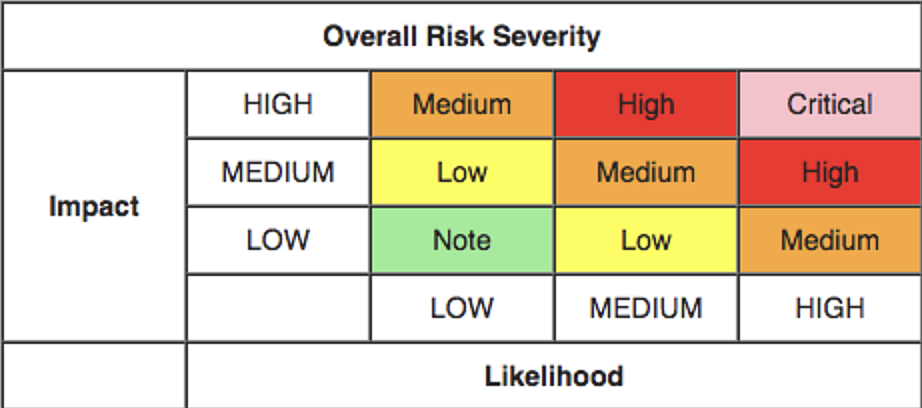
Step 5: Deciding what to fix
Once it's clear how serious all the potential risks are, the next step is to decide which risks to fix first. This decision is based on how severe the risks are. The ones labeled as "Critical" or "High" should be dealt with before the others because they pose the biggest threat to the organization.
During this decision-making process, there are some things to consider. Let's imagine a situation: Risk D is rated as having a medium level of severity. This means it's in the middle of the priority list. On one side, Risk D is common and costs the company about $5,000 every year. On the other side, fixing this risk in a way that will be effective in the long run would cost around $200,000.
Here's where it gets interesting. Sometimes, it might make sense to accept the yearly cost of $5,000 for Risk D. This is because there are other, more important risks to deal with first (and these are costing more than $5,000 each year). Also, the cost of fixing Risk D is extremely high (and the ROI can take years). This scenario shows us that it's not always the best choice to fix every single risk. Instead, a business might choose to incur the cost of $5,000 each year for Risk D. Spending $200,000 to fix it might not be worth it, especially if it's not a top priority and doesn't cause as much harm as other risks.
Step 6: Customizing your risk rating model
According to OWASP, having a risk ranking framework that is customizable for a business is critical for adoption. The reason for this is the amount of time that can go to waste wrangling about risk ratings when they're not corroborated by a model such as OWASP. The desired results can be achieved in a more efficient manner if the model itself is customized to match the perceptions of people involved regarding the seriousness of a risk. Some common ways to customize this model are:
- Adding factors: The evaluator can select varied factors to align with the organization's priorities. For instance, an AD use case could include impact factors like privilege escalation and data sensitivity. Likelihood aspects such as credential exposure and privilege abuse could also be incorporated.
- Customizing options: Customizing impact and likelihood options to reflect the organization's structure and preferences enhances the model's effectiveness. This involves incorporating team names, company specifics, and adjusting scores for accuracy. Comparing model-generated ratings with expert assessments helps fine-tune the model by aligning scores accordingly.
- Weighting factors: The given model treats all factors equally, but weighting factors based on business importance adds complexity. Assessors use weighted averages while keeping the process consistent. To refine the model, comparing its results with agreed-upon accurate business risk ratings for alignment is a recommended practice.
NIST SP 800-30 Rev.1
The National Institute for Standards and Technology's Special Publication 800-30— Guide for Conducting Risk Assessments— is probably one of the most complex models out there; but not without it's perks.
How the NIST SP 800-30 scoring (framework) works
In their publication, NIST clearly defines their risk assessment process. The image below illustrates the basic steps involved:
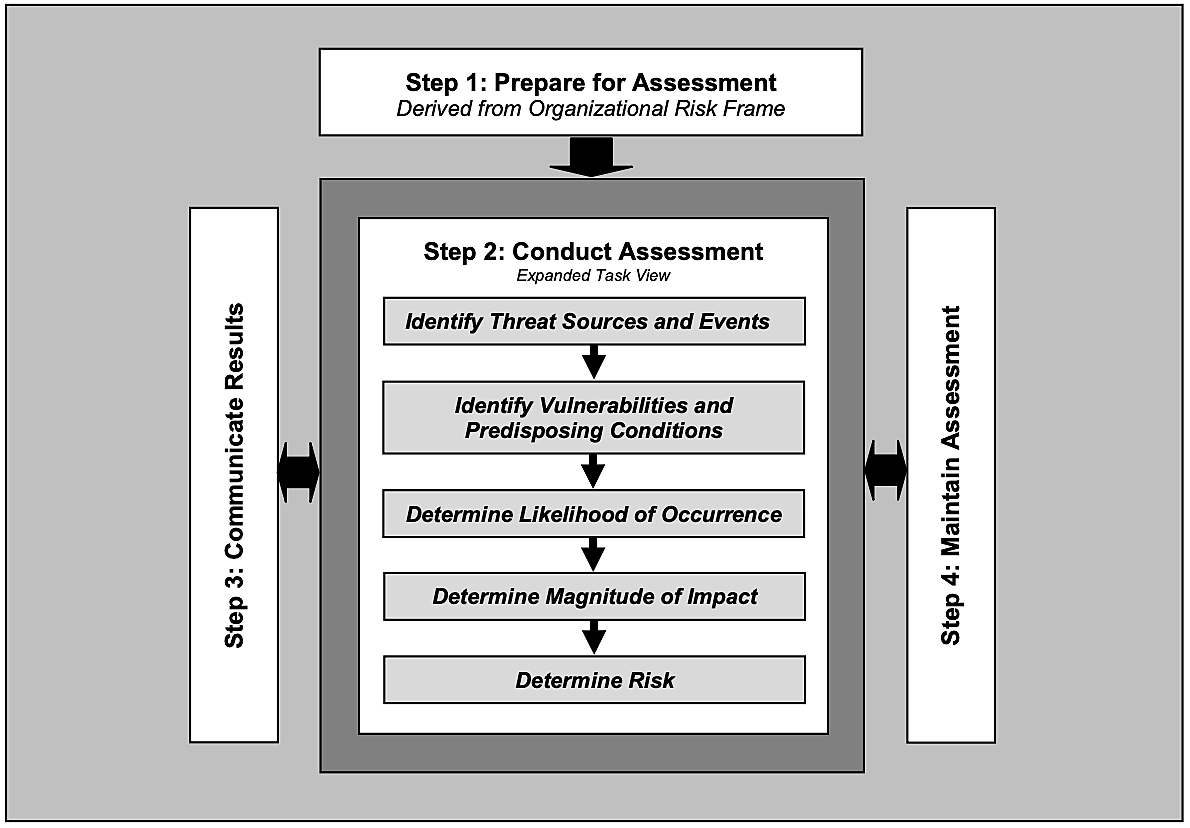
The steps involved in conducting an adversarial risk assessment:
Step 1: System characterization
The first step is is to detail all aspects of the system to be evaluated using the NIST SP 800-30 risk assessment standard. The system's components and data flow for its hardware, software, network environments, and other external systems' interfaces need to be defined clearly. Once the assessment scope has been defined and all the relevant aspects of the system are taken into consideration, the assessor can then move on to the next step.
Step 2: Threat source and threat event identification
For the second step, the assessor initiates the risk assessment process to identify potential threats, detect internal and external vulnerabilities in the system, and determine threat vectors by reviewing attack history and correlating it to the insights obtained through predictive analysis.
The assessor then needs to identify all the possible threat sources using an assessment scale for three considered factors:
- Adversary capability: Aims to gauge how capable the adversary and threat is. Sub-factors that need to be rated and then averaged to derive the adversary capability are tentative and should be evaluated based on the organization's expertise and preferences. Recommended sub-factors in respect to each vulnerability include: level of expertise, resourcefulness skills and opportunities available to exploit an active vulnerability. Here is the NIST adversary capability assessment scale:
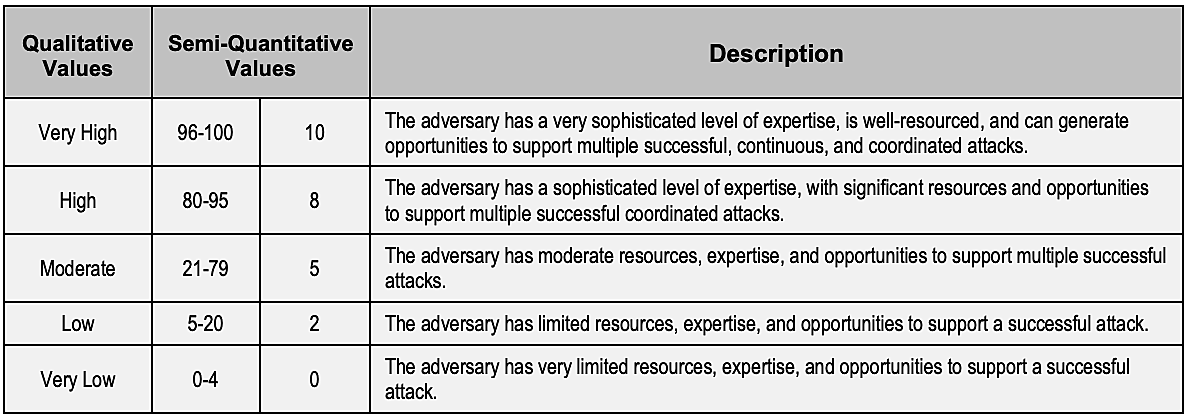
- Adversary intent: Aims to determine the intention of the adversary and threat. Exemplary sub-factors that need to be rated and then averaged to derive the adversary intent include: economic advantage gained over the business by exploiting the risk, the system's operational impediment, and the adversary's post-exploitation plans. Here is the NIST adversary intent assessment scale:
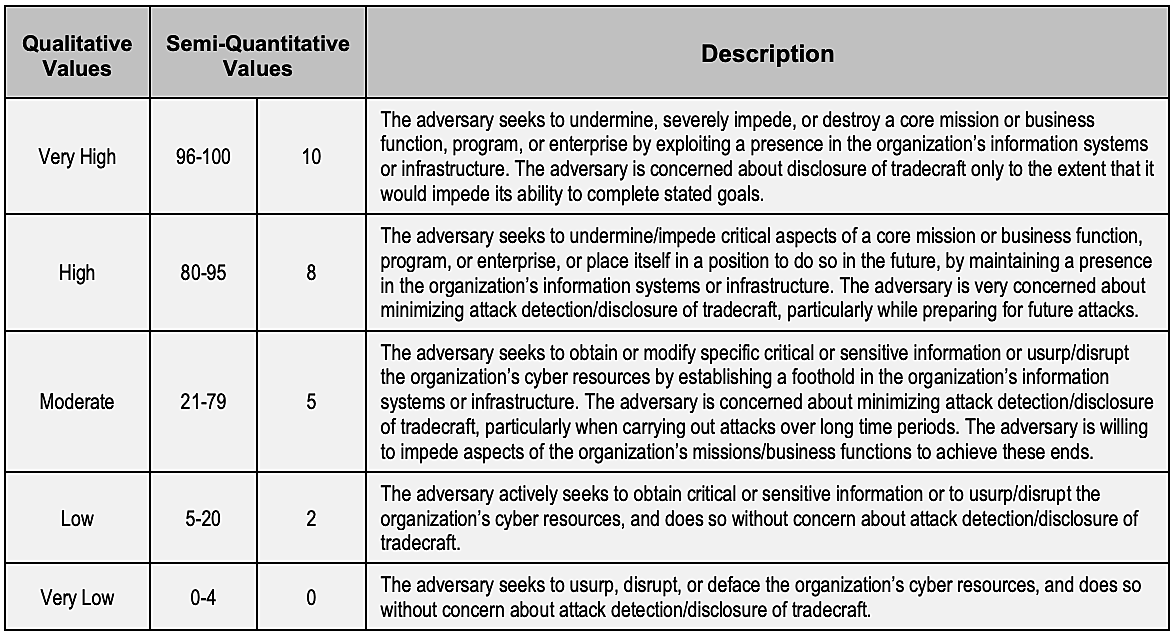
- Adversary targeting: Aims to determine how the adversary chooses to target organizations. Sub-factors are highly subjective and depend on organizational security posture, network infrastructure, and research information. Even so, the NIST assessment scale hints at determining how the adversary gains the information to target a specific organization:

After threat source identification, the next aim is to identify and determine the relevance of threat events. Potential threat events are established based on the considered vulnerabilities, which can differ from one organization to another, and NIST recommends characterizing the chosen vulnerabilities by TTPs. The document, NIST SP 800-30 Rev. 1, has a detailed characterization of threat events by TTPs.
Here is the NIST assessment scale for ranking the relevance of threat events:
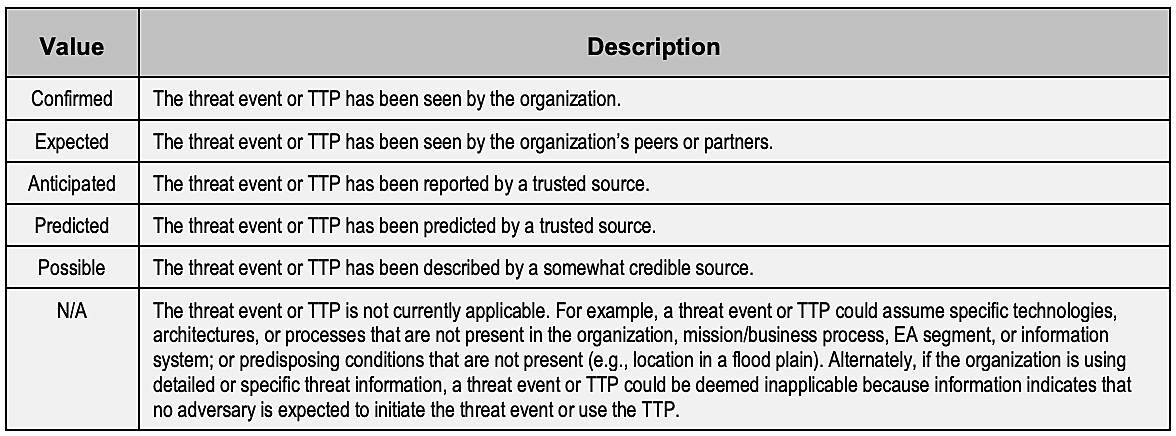
Step 3: Vulnerability identification
In this step, the objective is to identify and ascertain how severe each vulnerability is. Note that an organization can choose to skip this step if it already has decided on a set of risks and vulnerabilities it wants to target.
Next, previous risk assessments are scrutinized, and the reviews and comments from auditors are evaluated. Subsequently, security needs are mapped in contrast to the infrastructure-security test results.The advantage over here is that NIST SP 800-30 provides the ability to extract active vulnerabilities present in each defined system boundary.
Where the risk assessment is low, or where information about past assessments is not substantial or is not available, it is still possible to consider factors such as vulnerability exposure, ease of discoverability, and ease of exploitation.
Here is the NIST assessment scale for ranking the vulnerability severity:

Step 4: Control Analysis
This step is optional. NIST SP 800-30 evaluates the existing system controls in place, and any additional controls that need to be defined depending on the requirement. Ultimately, the assessor should work with a comprehensive list of existing and planned controls.
Unlike ISO 27005, an international standard for IT risk assessment where the control analysis preceded vulnerability analysis, NIST SP 800-30 identifies system and identity-related vulnerabilities from the ground up prior to the incorporation of mitigation by already existing controls.
Step 5: Likelihood determination
This results when the information gathered in the first four steps establishes the primary weaknesses in the identity environment. The assessor needs to determine how likely it is for threats to materialize. This step is equivalent to the preparation of threat profiles under the OCTAVE approach.
This is a process where each threat is given a likelihood rating. There are two assessment scales involved:
The first process determines the likelihood of a threat event initiation (adversarial), in which the assessor assigns rating values ranging from 0 to 100, or 0 to 10. Either can be further divided into sub-ranges with corresponding qualitative values.
Here is the NIST assessment scale for ranking the likelihood of threat event initiation (adversarial):

The second thing to determine is the likelihood of a threat event resulting in adverse impact. Again, the assessor is required to assign rating values ranging from 0 to 100 and/or 0 to 10; and the sub-ranges involved have a qualitative correspondent.
Here is the NIST assessment scale for ranking the likelihood of threat event resulting in adverse impact:

Once both likelihood calculations are completed, the final step in this stage is determining the overall likelihood by referencing the assessment scale below. Using this correlation matrix, the assessor can map the overall likelihood by considering threat event initiations and the resulting threat events as adverse impacts.
Here is the NIST assessment scale for ranking the overall likelihood:

Example: If Risk A has a qualitative rating of "Low" for likelihood of threat event initiation and "High" for likelihood of threat events resulting in adverse impact, the overall likelihood would be "Moderate."
Step 6: Impact determination
Once likelihood has been determined, the next step is to determine the impact of threat events, for example how severe the impact would be on the business if a this vulnerability is exploited. Usually, impact factors include:
- Loss of confidentiality: The degree and amount of sensitive data disclosed
- Loss of integrity: The degree and amount of data corrupted
- Loss of availability: The number and type of services interrupted; example of these types include secondary services and primary services
Exemplary types of impact stated by NIST include :
- Harm to operations
- Harm to assets
- Harm to individuals
- Harm to other organizations
- Harm to the nation
Note: Please remember that the factors for determining impact can be highly subjective and change according to organizational needs, suitability, and preferences.
Step 7: Risk determination
This is the final step pertaining to numerical calculation and analysis. The level of risk is determined in a qualitative manner by correlating the threat likelihood and magnitude of impacts using the correlation matrix. The qualitative outputs can then be quantified into risk ratings or risk scores.
Here is the NIST correlation matrix for determining the qualitative level of risk:

For example, Risk B has a likelihood rating of "Moderate" and an impact rating of "High." This means that the overall rating of Risk B is "Moderate."
A "Moderate" qualitative rating corresponds to a semi-quantitative rating of 21 to 79 out on a scale of 0 to 100 or 3 to 5, according to the NIST'S assessment scale:
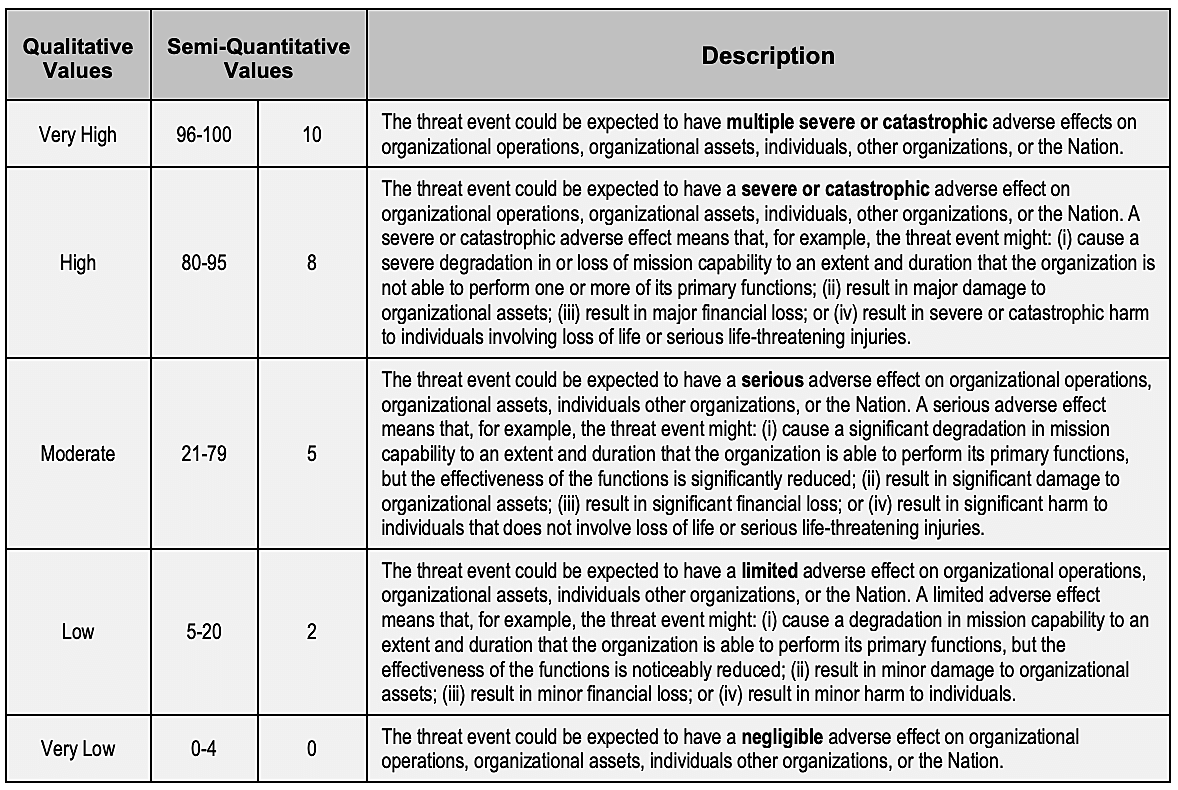
Therefore, according to the assessment scale, Risk B has a qualitative rating of Moderate, and a semi-quantitative rating of 21 to 79.
Step 8: Control recommendations and risk documentation
In this post-numerical calculation and analysis stage, the concluding control recommendations are suggested. Those recommendations could be concerned with a reduction in the threat likelihood or the impact-mitigation to decrease the risk score.






















